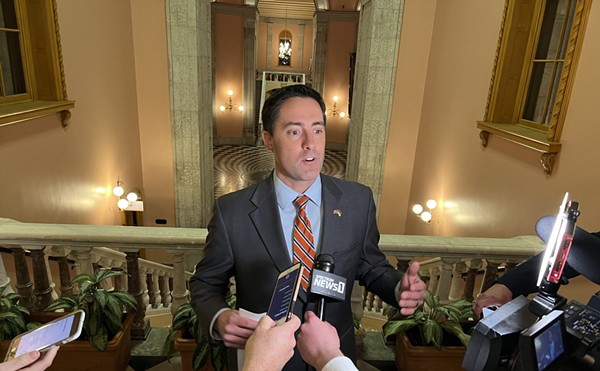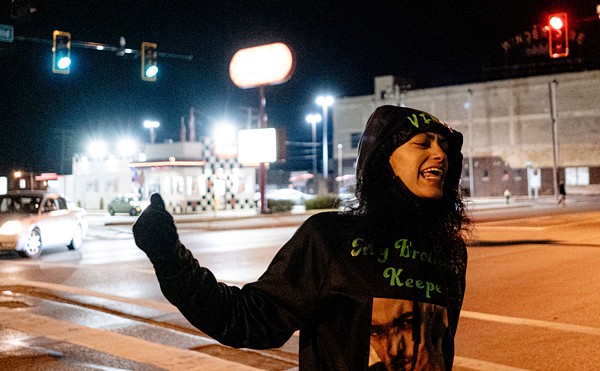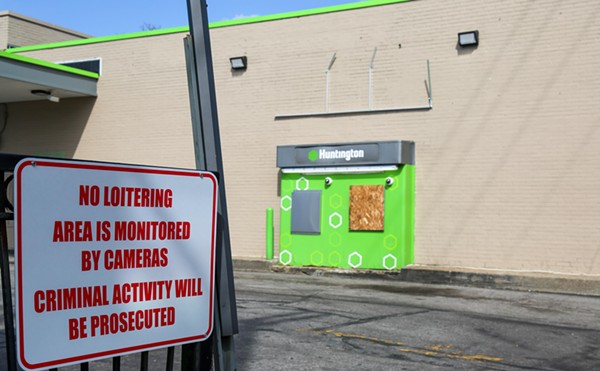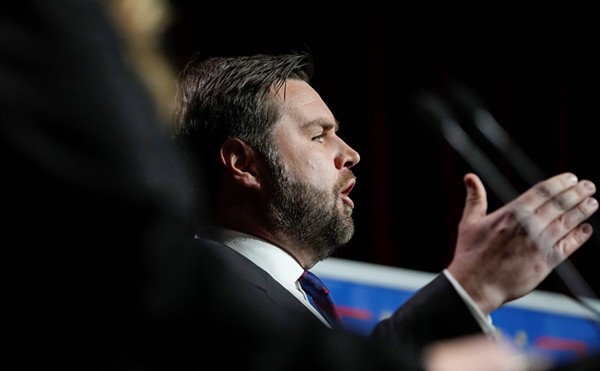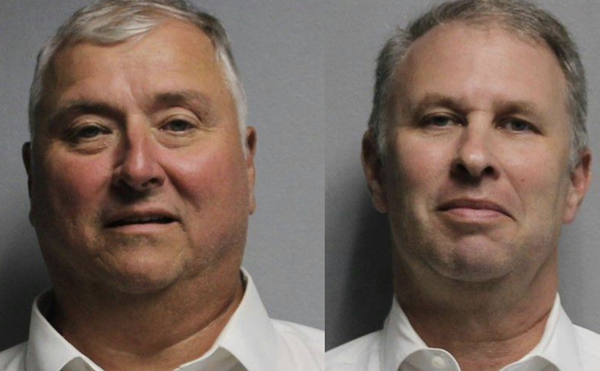Krista Napp's mind is swirling with thoughts of May 4. The 40th anniversary of the shootings at Kent State University is fast approaching, and the co-chair of the school's May 4 Task Force is swamped by mounting requests from media types and others who want to know what's going on at the commemoration this year.
Some ask her to reserve spots for the somber candlelight vigil. A school in Colorado wonders if the Task Force could provide a live stream of the anniversary for students in their classes. And then there are the doves.
A few months back, a woman asked whether they would be interested in borrowing her doves for the day. She loans them out for events that emphasize peace, and she figured they'd be a good omen for the May 4 commemoration. They're really amazing doves, the lady suggests — magic doves. They know how to open a basket, then circle in formation around it very symbolically.
The Task Force liked the idea, and agreed that when the campus victory bell rings, the doves will be unleashed to grace the sky, then fly 45 miles back to their home in Fairview Park, just as they are trained to do.
Over the course of four decades, the May 4 Task Force has mobilized numerous protests and other events to honor the four students killed on that day in 1970: Allison Krause, Jeffrey Miller, Sandra Scheuer, and William Schroeder.
Few seem to remember the events surrounding the shootings: President Nixon's decision to send troops to Cambodia that galvanized anti-war protesters across the nation; the melee that occurred in downtown Kent on May 1, when drunken students and demonstrators set a bonfire in the street and broke windows in downtown stores to demonstrate opposition to the political-military establishment; the governor's decision to send in the National Guard to restore order; and the sickening feeling that pervaded the town when students, faculty, and townspeople learned what transpired on the grassy campus shortly after noon on May 4.
Few recall how the event catapulted Kent into the international spotlight, or the national student strike that followed on more than 400 campuses. Fewer still know that, despite legal challenges mounted by victims and parents of the slain students, none of the guardsmen was held legally responsible for the shootings. To this day, no one knows exactly why they fired at unarmed students, although multiple theories abound.
Of course, to most KSU students and Kent residents, it all amounts to fossilized remains of political dinosaurs that engender a pause, sigh, or even a yawn. But not to Krista Napp.
A 21-year old junior from Conneaut, Napp joined the Task Force a year ago when she realized that her liberal perspectives were a perfect match for the group, if perhaps not for her own family. Her father, a former student at Kent State, was a Guardsman stationed in Cleveland on May 4, 1970; but for a quirk of fate, he might have been called in to Kent that day. Dad is supportive of Krista's work with the Task Force. But he reminds her that there are two sides to every story.
With a dab of makeup and lip gloss, her blond hair covering an underside layer of dyed purple, Napp blends her political and fashion tastes seamlessly. She tends toward a wardrobe of T-shirts promoting bands like the Dead Kennedys, the politically charged Reagan-era punk band that broke up three years before she was born.
The May 4 Task Force meets every Thursday evening at the campus library, in a solemn room that is anchored by a picture of the four slain students and a sketch of the confrontation. Planning this year's activities has been at the center of the group's efforts since fall.
Napp and co-chair Nora Rodriquez sit in the middle of a table at the front of the room, flanked by dueling laptops. Seated at the right of the table is Alan Canfora, a founding member of the Task Force and the tragedy's most visible, visceral remnant — a legend in Kent political circles. Waving a black anarchist flag during the May 4 demonstration, Canfora was among the nine students wounded by guardsmen, his right wrist stung by a bullet.
A co-founder of the Task Force, he became the singular voice for unrelenting opposition to the university's decision in the '70s to build a gymnasium adjoining the site of the shootings. In the 1980s, he lamented that the memorial built in honor of the shootings amounted to only seven percent of its original grand design. Today, Canfora maintains his liberal roots by chairing the Barberton Democratic Party and operating a website dedicated to May 4. To some, he is an aging hippie who can't forget the past; to others a hero who has given moral voice to the victims.
On this evening, the singular voice for unrelenting opposition is handing out Girl Scout cookies to the Task Force — a motley group of 30 students, longtime members, and Kent residents with progressive political views.
The first item up for discussion: trees. Several members express concern that trees planted over the years near Taylor Hall create the mistaken impression that the guardsmen's views were blocked when they fired their rifles. Those for whom the shootings remain etched in memory know the soldiers' view was unobstructed.
Rodriquez types feverishly, then reads back what she has entered. "These trees undermine the historical integrity of the May 4 memorial site. We would like to see the four trees removed."
A sophomore from Lorain majoring in photojournalism, Rodriquez joined the Task Force this year. She was intrigued by the storied history of the movement and impelled by the excitement that comes from working long hours for a cause. Endlessly upbeat, she embodies the optimism of the group's youthful members, who experience May 4 not as a sad personal reminiscence, but as part of the portentous arc of history. And history seems to say those trees have got to go.
The group also wants the university to create more scholarships in honor of the May 4 victims, and any student who receives such money would be required to work on commemorative initiatives.
Back in February, Napp was thrilled that some big musical groups would be performing at the 40th anniversary. She couldn't reveal at the time who was onboard, but she hoped to go public with the news by early spring. A reasonable guess might have been Crosby, Stills, Nash & Young, who performed their anti-war anthem "Ohio" at the 1997 commemoration.
But when the topic is broached at the March meeting, the news is not good. Canfora reveals that after months of promising phone calls with the California agents of CSN&Y, he has just been informed that they will not be coming to Kent in May. "I feel kind of stupid getting everybody's hopes up about Crosby Stills, Nash & Young, who now I despise," he says. "I never did really like that song too much."
There is grumbling. One person expresses disappointment, another criticizes Neil Young. Canfora, ever the optimist, says he is convinced that Devo — the rock group launched by KSU art students, whose song "Whip it" was a huge hit a decade after May 4 — will perform. "Devo will pack 'em in," says Canfora. Moby and Michael Stanley are also in the picture.
As the clock strikes 8, the meeting breaks up, and Rodriquez and Napp pack up their laptops and head home. There's homework to do and e-mails to answer.
Today's May 4 Task Force is made up of about 50 students who remain passionate about preserving the memory of the slain students. But talk to others who sling textbooks across the infamous college green, and you get a very different picture. Typically, they greet May 4 questions with a pause, as if they are quickly searching their minds for the right thing — perhaps anything — to say.
"I really don't think people talk about it that much," says Sarah Spinelli, an English major with an easy smile, as she closes down a coffee kiosk at the library. "I think this generation is a little disconnected from it; it's not something we experienced firsthand or even secondhand."
For most on campus, awareness of the shootings is shaped by regular coverage devoted to it in The Daily Kent Stater, the student newspaper that was at the center of it all in 1970 and still plays up May 4 during the annual commemoration.
Students pass by the memorial, but they don't really think about it, says Candice Binggeli, a senior from Olmsted Falls majoring in visual communication design. She's taking an interdisciplinary course on May 4 this term, and she often finds herself excitedly telling friends, "Hey, this is what I learned ..." or "Did you know this?"
"Oh yeah, it's crazy," they say politely, then they return to whatever they were doing.
Pressed for an answer, most students will tell you they are aware that this is the 40th anniversary. None seem to know the names of the slain students, though they have probably passed the markers bearing those names hundreds of times. The university, for its part, has tried to teach students to "inquire, learn, reflect," to cite the inscription that appears on the memorial. Classes are canceled from noon to 2 p.m. on May 4.
Professors Laura Davis and Carole Barbato are among the faculty members who have devoted countless hours over the past two years preparing special events for the 40th anniversary. Barbato, a KSU junior in 1970, was a friend of slain student Sandy Scheuer. Davis, a KSU freshman at the time, attended the rally that took place that day.
"There are times when your emotions do bubble up," says Barbato. "And we do have flashbacks. And so we go to the bathroom. We cry, and then we come back and roll up our sleeves and get to work. Because that's what needs to be done."
Kent State administrators have plans of their own this May 4. Officials are touting the opening of a visitors center in Taylor Hall, which overlooks the site of the shootings. The center is in nascent form, though administrators hope to raise $1 million to fully develop it as a historical museum. Its contents emerged from campus and community forums — the school's attempt to offer a cross section of the numerous perspectives that linger even today. The university expects to raise the money within a few years, though its difficulties in raising funds for the May 4 memorial a generation ago give one pause.
"Even people who thought that having the memorial was a good idea were reluctant to put money into the project," remembers Dr. Michael Schwartz, who was president of Kent State from 1982 to 1991 and later went on to lead Cleveland State University.
Iris Harvey, Kent State's VP of university relations, says the visitors center will have a different tone and orientation than the more somber memorial. She also suggests that the political environment today is more favorable to a visitors center than it was to a memorial back in the '80s.
It's all part of what Schwartz calls "the great saga" of May 4. "There's a very dramatic aspect to it, as the story is told over and over and over again to new generations of students."
In Kent, as in William Faulkner's fictional world, "the past is never dead; it's not even past."
A month after the March task force meeting, the idealism of Napp and Rodriquez has taken a sober turn.
The university is moving more slowly than the task force would like on trees and scholarships. The administration plans to "assess the need to prune the trees so they do not obstruct the site," says Harvey. But, she adds, "the university prides itself on using environmentally sound practices. Cutting down trees would be counter to our environmental approach, inconsistent with our designation as a 'tree campus,' and extremely costly."
KSU is committed to providing financial aid to students, adds Harvey. But she insists that May 4 scholarships must be viewed in the larger context of the university's commitment to helping tens of thousands of students who could benefit from aid. Moreover, other administrators say, the school just doesn't have the money to step up its scholarships now.
Thirty years ago, the Task Force would have been on the barricades fighting such decisions. Today, the mood is more one of resignation and acceptance.
All this, plus more bad news on the music front: Devo won't be playing the 40th anniversary. Apparently, there is not enough time to promote the band in order to sell the number of tickets needed to cover costs. On the plus side, Devo bassist Gerald Casale, who as a KSU student witnessed the shootings, promises to be there to share his perspectives at the podium. And Country Joe McDonald — the Woodstock performer famed for his "I-Feel-Like-I'm-Fixin'-to-Die Rag" with its chorus "One, two, three, what are we fighting for?" — will strap on a guitar, says Rodriquez.
It's not exactly CSN&Y, but they think it will keep the anticipated crowd of 4,000 happy.
As May 4 approaches, flowers are sprouting at the memorial. The 58,000 daffodils that symbolize the deaths of American soldiers in Vietnam are blossoming. In less than a week, thousands will gather to honor the students who were killed and injured. They will partake in the all-night vigil, they will listen to speeches, and they will cry. They will recognize, as senior Sarah Spinelli says, that 40 years ago something significant happened at Kent State.
Rick Perloff is Director of the School of Communication at Cleveland State University. In May 1970, he reported on the incidents at Kent State for his college newspaper.



